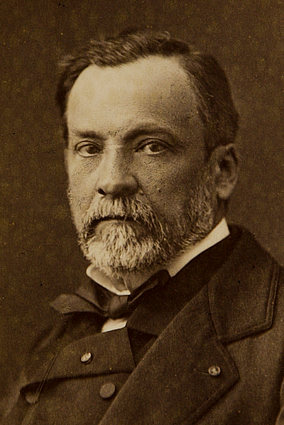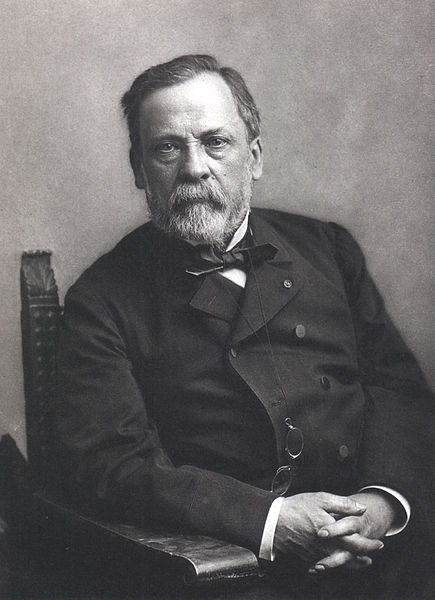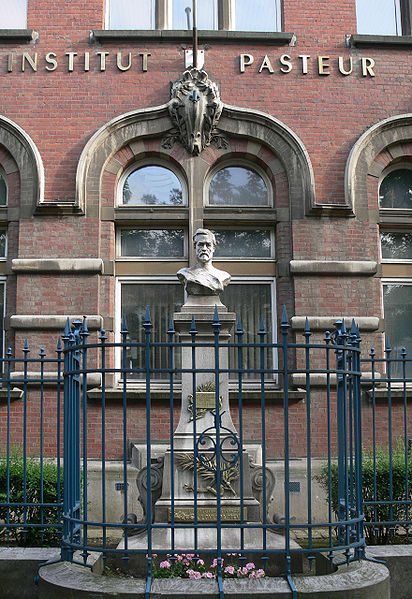<Back to Index>
- Microbiologist Louis Pasteur, 1822
- Poet Mirza Asadullah Baig Khan (Ghalib), 1797
- King of Saxony Anthony, 1755
PAGE SPONSOR



Louis Pasteur (December 27, 1822 – September 28, 1895) was a French chemist and microbiologist born in Dole. He is remembered for his remarkable breakthroughs in the causes and preventions of diseases. His discoveries reduced mortality from puerperal fever, and he created the first vaccine for rabies and anthrax. His experiments supported the germ theory of disease. He was best known to the general public for inventing a method to stop milk and wine from causing sickness, a process that came to be called pasteurization. He is regarded as one of the three main founders of microbiology, together with Ferdinand Cohn and Robert Koch. Pasteur also made many discoveries in the field of chemistry, most notably the molecular basis for the asymmetry of certain crystals. His body lies beneath the Institute Pasteur in Paris in a spectacular vault covered in depictions of his accomplishments in Byzantine mosaics.
Louis Pasteur was born on December 27, 1822, in Dole in the Jura region of France, into the family of a poor tanner. Louis grew up in the town of Arbois. He gained degrees in Letters and in Mathematical Sciences before entering the École Normale Supérieure, an elite college. After serving briefly as professor of physics at Dijon Lycée in 1848, he became professor of chemistry at the University of Strasbourg, where he met and courted Marie Laurent, daughter of the university's rector, in 1849. They were married on May 29, 1849, and together had five children, only two of whom survived to adulthood; the other three died of typhoid. These personal tragedies inspired Pasteur to try to find cures for diseases such as typhoid.
In Pasteur's early work as a chemist, he resolved a problem concerning the nature of tartaric acid (1848). A solution of this compound derived from living things (specifically, wine lees) rotated the plane of polarization of light passing through it. The mystery was that tartaric acid derived by chemical synthesis had no such effect, even though its chemical reactions were identical and its elemental composition was the same. This was the first time anyone had demonstrated chiral molecules.
Pasteur's doctoral thesis on crystallography attracted the attention of W.T. Fuillet and he helped Pasteur garner a position of professor of chemistry at the Faculté (College) of Strasbourg.
In the year of 1854, Louis was named Dean of the new Faculty of Sciences in Lille. (It was on this occasion that Pasteur uttered his oft-quoted remark: "...dans les champs de l'observation, le hasard ne favorise que les esprits préparés" (In the field of observation, chance favors only the prepared mind.)) In 1856, he was made administrator and director of scientific studies of the École Normale Supérieure.
Pasteur demonstrated that fermentation is caused by the growth of micro-organisms, and that the emergent growth of bacteria in nutrient broths is not due to spontaneous generation but rather to biogenesis (Omne vivum ex ovo). He exposed boiled broths to air in vessels that contained a filter to prevent all particles from passing through to the growth medium, and even in vessels with no filter at all, with air being admitted via a long tortuous tube that would not allow dust particles to pass. Nothing grew in the broths unless the flasks were broken open; therefore, the living organisms that grew in such broths came from outside, as spores on dust, rather than spontaneously generated within the broth. This was one of the last and most important experiments disproving the theory of spontaneous generation. The experiment also supported germ theory.
While Pasteur was not the first to propose germ theory (Girolamo Fracastoro, Agostino Bassi, Friedrich Henle and others had suggested it earlier), he developed it and conducted experiments that clearly indicated its correctness and managed to convince most of Europe it was true. Today he is often regarded as the father of germ theory and bacteriology, together with Robert Koch.
Pasteur's research also showed that the growth of micro-organisms was responsible for spoiling beverages, such as beer, wine and milk. With this established, he invented a process in which liquids such as milk were heated to kill most bacteria and moulds already present within them. He and Claude Bernard completed the first test on April 20, 1862. This process was soon afterwards known as pasteurization.
Beverage contamination led Pasteur to the idea that micro-organisms infecting animals and humans cause disease. He proposed preventing the entry of micro-organisms into the human body, leading Joseph Lister to develop antiseptic methods in surgery.
In 1865, two parasitic diseases called pébrine and flacherie were killing great numbers of silkworms at Alais (now Alès). Pasteur worked several years proving it was a microbe attacking silkworm eggs which caused the disease, and that eliminating this microbe within silkworm nurseries would eradicate the disease.
Pasteur also discovered anaerobiosis, whereby some micro organisms can develop and live without air or oxygen, called the Pasteur effect.
Pasteur's later work on diseases included work on chicken cholera. During this work, a culture of the responsible bacteria had spoiled and failed to induce the disease in some chickens he was infecting with the disease. Upon reusing these healthy chickens, Pasteur discovered that he could not infect them, even with fresh bacteria; the weakened bacteria had caused the chickens to become immune to the disease, even though they had only caused mild symptoms.
His assistant Charles Chamberland (of French origin) had been instructed to inoculate the chickens after Pasteur went on holiday. Chamberland failed to do this, but instead went on holiday himself. On his return, the month old cultures made the chickens unwell, but instead of the infection being fatal, as it usually was, the chickens recovered completely. Chamberland assumed an error had been made, and wanted to discard the apparently faulty culture when Pasteur stopped him. Pasteur guessed the recovered animals now might be immune to the disease, as were the animals at Eure-et-Loir that had recovered from anthrax.
In the 1870s, he applied this immunization method to anthrax, which affected cattle, and aroused interest in combating other diseases. Pasteur publicly claimed he had made the anthrax vaccine by exposing the bacillus to oxygen. His laboratory notebooks, now in the Bibliothèque Nationale in Paris, in fact show Pasteur used the method of rival Jean-Joseph-Henri Toussaint, a Toulouse veterinary surgeon, to create the anthrax vaccine. This method used the oxidizing agent potassium dichromate. Pasteur's oxygen method did eventually produce a vaccine but only after he had been awarded a patent on the production of an anthrax vaccine.
The notion of a weak form of a disease causing immunity to the virulent version was not new; this had been known for a long time for smallpox. Inoculation with smallpox was known to result in far less scarring, and greatly reduced mortality, in comparison with the naturally acquired disease. Edward Jenner had also discovered vaccination, using cowpox to give cross immunity to smallpox (in 1796), and by Pasteur's time this had generally replaced the use of actual smallpox material in inoculation. The difference between smallpox vaccination and anthrax or chicken cholera vaccination was that the weakened form of the latter two disease organisms had been generated artificially, and so a naturally weak form of the disease organism did not need to be found.
This discovery revolutionized work in infectious diseases, and Pasteur gave these artificially weakened diseases the generic name of vaccines, in honour of Jenner's discovery. Pasteur produced the first vaccine for rabies by growing the virus in rabbits, and then weakening it by drying the affected nerve tissue.
The rabies vaccine was initially created by Emile Roux, a French doctor and a colleague of Pasteur who had been working with a killed vaccine produced by desiccating the spinal cords of infected rabbits. The vaccine had only been tested on eleven dogs before its first human trial.
This vaccine was first used on 9 year old Joseph Meister, on July 6, 1885, after the boy was badly mauled by a rabid dog. This was done at some personal risk for Pasteur, since he was not a licensed physician and could have faced prosecution for treating the boy. After consulting with colleagues, Pasteur decided to go ahead with the treatment. Meister did not contract the disease. It is sometimes said that Pasteur saved the boy's life; but this cannot be maintained with certainty, since the risk of contracting rabies after such an exposure is estimated at around 15%. Nonetheless, Pasteur was hailed as a hero and the legal matter was not pursued. The treatment's success laid the foundations for the manufacture of many other vaccines. The first of the Pasteur Institutes was also built on the basis of this achievement.
Legal risk was not the only kind Pasteur undertook. In The Story of San Michele, Axel Munthe writes of the rabies vaccine research:
| “ | Pasteur himself was absolutely fearless. Anxious to secure a sample of saliva straight from the jaws of a rabid dog, I once saw him with the glass tube held between his lips draw a few drops of the deadly saliva from the mouth of a rabid bull-dog, held on the table by two assistants, their hands protected by leather gloves. | ” |
Because of his study in germs, Pasteur encouraged doctors to sanitize their hands and equipment before surgery. Prior to this, few doctors or their assistants practiced the procedure of washing their hands and equipment.
In 1995, the centennial of the death of Louis Pasteur, the New York Times ran an article titled "Pasteur's Deception". After having thoroughly read Pasteur's lab notes, the science historian Gerald L. Geison declared that Pasteur had given a misleading account of the preparation of the anthrax vaccine used in the experiment at Pouilly-le-Fort. Max Perutz published a vigorous defense of Pasteur in the New York Review of Books.
Although his grandson, Louis Pasteur Vallery-Radot, wrote that Pasteur had only kept from his Catholic background a spiritualism without religious practice, Catholic observers often said that Louis Pasteur remained throughout his whole life an ardent Christian, and his son - in - law, in perhaps the most complete biography of Louis Pasteur, writes:
Maurice Vallery-Radot, grandson of the brother of the son-in-law of Pasteur and outspoken Catholic, also holds that Pasteur fundamentally remained Catholic. According to both Pasteur Vallery-Radot and Maurice Vallery-Radot, the well known quotation attributed to Pasteur: "The more I know, the more nearly is my faith that of the Breton peasant. Could I but know all I would have the faith of a Breton peasant's wife." is apocryphal.
Pasteur's
principal works are: "Etudes sur le Vin", (1866); "Etudes sur le
Vinaigre" (1868); "Etudes sur la Maladie des Vers à Soie" (2
vols., 1870); "Quelques Réflexions sur la Science en France"
(1871); "Etudes sur la Bière" (1876); "Les Microbes
organisés, leur rôle dans la Fermentation, la
Putréfaction et la Contagion" (1878); "Discours de
Réception de M.L. Pasteur à l'Académie Française" (1882); "Traitement de la Rage" (1886).
Pasteur won the Leeuwenhoek medal, microbiology's highest Dutch honor in Arts and Sciences, in 1895. He was a Grand Croix of the Legion of Honor – one of only 75 in all of France. Both Institute Pasteur and Université Louis Pasteur were named after him.
In many localities worldwide, there are streets named in his honor. For example, in the USA: the Medical school at Stanford University, Palo Alto and Irvine, California, Boston, Massachusetts, and Polk, Florida, adjacent to the University of Texas Health Science Center at San Antonio; Jonquière, Québec; San Salvador de Jujuy and Buenos Aires (Argentina), Great Yarmouth in Norfolk, in the United Kingdom, Jericho and Wulguru in Queensland, (Australia); Phnom Penh in Cambodia; Ho Chi Minh City in Vietnam; Batna in Algeria; Bandung in Indonesia, Tehran in Iran, adjacent to the Odessa State Medical University in Odessa, Ukraine; Milan in Italy and Bucharest, Cluj-Napoca and Timişoara in Romania.
In his honor, there is a statue for him located on the campus of San Rafael High School in San Rafael, California. Also there is a Pasteur institute in Ootakamund, a hill station in south India, which is involved in vaccine trials and also rabies diagnosis.
In his triumphal lecture at the Sorbonne in 1864, Pasteur said "Never will
the doctrine of spontaneous generation recover from the mortal blow
struck by this simple experiment" (referring to his swan neck flask
experiment wherein he proved that fermenting micro - organisms would not
form in a flask containing fermentable juice until an entry path was
created for them).
- Avenue Louis Pasteur in the Longwood Medical and Academic Area in Boston, Massachusetts, is named in his honor in the French manner with "Avenue" preceding the name of the dedicatee.
- The Avenue Pasteur in Saigon, Vietnam, is one of the few streets in that city to retain its French name.
- In the television program Star Trek: The Next Generation, the show's main characters complete the final mission aboard the U.S.S. Pasteur. The show's chief medical officer is portrayed as being the captain of this ship in the future (relative to the show's main story line), which can be seen as a tribute to Pasteur by selecting his name for this medical ship.